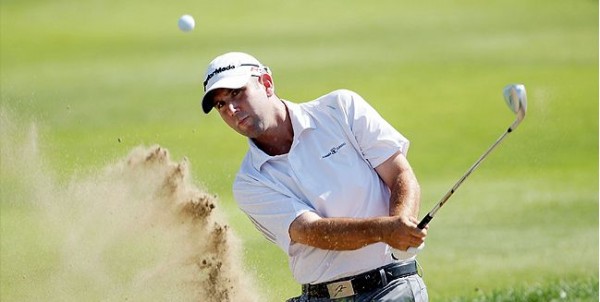Opinion & Analysis
10 PGA Tour players who will rise (or fall) in 2014

With the 2014 PGA Tour season starting, I wanted to give the readers a look at a few players on Tour that I feel will be on the rise and falling for the season. The data below is the player’s 2013 metrics.
Players on the Rise
NICOLAS COLSAERTS
Colsaerts was the hot prospect headed for the Tour in 2013 coming off splendid play at the 2012 Ryder Cup. He generates a ton of club head speed and is one of the longer hitters on Tour. He was also eighth in approach shots from the rough and fourth in approach shots from the fairway. Thus, he’s an excellent iron player if he keeps the ball in play. He actually drove the ball quite well for most of the season, but he regressed toward the end of the year.
The reason why I like Colsaerts is that he hits it so long and hits it so well with his irons that the only part of the game that held him back was on and around the greens. And where he excelled with his irons was in the ever-important Danger Zone. He also was first in shots from 225-to-250 yards.
Colsaerts was saddled with the strongest strength of schedule on Tour last year, while only ranking 100th in Purse Size per Event. I believe that he can get used to the greens along with working on his putting in the offseason that he will have much more success in 2014. As I have mentioned in Pro Golf Synopsis, the biggest statistical advantage that distance provides is it allows the golfer to putt overcome poor putting. This is due to the par-5’s on Tour playing more like par-4’s for long hitters such as Colsaerts. Therefore, he can still be a mediocre putter on Tour and have a big year. He just needs to stop putting like one of the worst putters on Tour.
CHARLES HOWELL III
Howell has been one of the most overrated ballstrikers in recent years and subsequently one of the most underrated in terms of short game and putting. What has happened is that he has steepened his angle of attack with the driver over time. I have written about this in Pro Golf Synopsis, where the most common trait of a golfer who “loses their driving” on Tour is the one who starts to struggle with his accuracy off the tee and to counter that he tries to fly the ball lower by hitting more and more downward on the ball. This may provide some initial relief for the golfer, but eventually he not only starts losing distance off the tee, but he becomes more inaccurate and imprecise off the tee as well.
Here is a look at Howell’s radar metrics during the past three years:
Frustrated, Howell started to work with Grant Waite for much of the second half of 2013 in order to improve shallow out his attack angle. Here is a look of his radar metrics in the fall 2013-2014 season:
This created a noticeable improvement in his ballstriking in the 2013-2014 fall season. Here is a look at his rankings in the key ballstriking metrics in those tournaments he played in:
Granted, his rankings in these events is out of roughly 120 players versus his cumulative rankings in 2013 being out of 190 players. But, he is currently in the top-10th percentile in driving and entirely better from each of the zones. With his club head speed, putting and short game he can take this much improved ballstriking and set target for having a spectacular 2014.
MATT JONES
Jones’ metrics may not impress many golfers. Last year I wrote about how PGA Tour players only need to be average or better in four areas of the game.
- Driving Effectiveness
- Danger Zone (175 to 225 yards) Play
- Putts Gained
- Short Game Shots from 10 to 20 yards
There is a very strong correlation between Tour players that finish in the top-half in these categories and their success on Tour. Not only do golfers that achieve “The Power of Being Average” usually keep their cards, but they tend to have wildly successful seasons. Jones finished a very respectable 49th on the money list. But even more impressive was his ranking of 29th in Adjusted Scoring Average. His Purse Size per Event is likely to improve and if he has the talent to achieve each of the “Big Four” areas of the game, he has a good chance to carrying it over to 2014 and having a terrific season.
JOHN SENDEN
While Senden’s metrics were not impressive, 2013 was a down year for him. Senden is well known for his ballstriking and is usually one of the premier ballstrikers on Tour from off the tee and on shots longer than 175 yards.
Since Senden did not lose any club head speed, I believe that he will regain his ballstriking in 2014. Furthermore, he was hampered by his inability to make putts from longer than 15 feet. He ranked 153rd in make percentage from long distance and historically that metric means he should progress toward the mean.
JOSH TEATER
Teater just missed finishing in the top half of “The Big Four” (Driving Effectiveness, Danger Zone, Short Game Shots and Putts Gained) as he ranked 96th in Putts Gained.
If there are worries about his game, he tends to miss a high percentage of the time to the right (60.5 percent) and that his ranking in Adjusted Scoring Average (82nd) should have been much better given his key performance metrics. This indicates that Teater may have some issues with his strategy.
In the end, it is difficult to take away from a player that almost executed “The Big Four” and did it against top-tier competition. Furthermore, parts of his issues with the putter were from long distance as he ranked 138th in make percentage from beyond 15 feet. This should progress toward the mean in 2014.
PLAYERS ON THE DECLINE
JOHN MERRICK
Typically, Merrick has been a very good driver of the ball and has had some issues with his iron play. In the past two seasons, he has made strides to improve his iron play, but his driving has regressed. Last year he started off the season as one of the premier Danger Zone players on Tour, while driving the ball very effectively and putting well to win his first-ever PGA Tour event, the Northern Trust Open at Riviera Country Club.
Since then, Merrick has only made an average of $35,566 per event played, which would have ranked 105th on Tour. Merrick benefited from playing a fairly soft schedule that had a fairly high purse size per event. Those two rankings should be more similar in 2014, which means that his strength of schedule should become tougher while his average Purse Size per Event should drop slightly and that would make it more difficult for him to have success.
DEREK ERNST
Ernst benefited from his surprise victory at the Wells Fargo Championship at Quail Hollow after making it through the Monday qualifier. He was a good driver of the ball in 2013, but did not do much well beside that. He performed poorly in each of the zones and was the second worst on Tour on short game shots from 10-to-20 yards. He was also a mediocre putter.
That does not make for good prospects in 2014, and he finished out the 2013 missing nine of his past 13 cuts with a best finish of T-44th. One of the big things Ernst has going for him is his world-class club head speed. If he can use that speed to his advantage and start bombing shots off the tee, all he needs is one good week of golf and he can get into contention for another victory. But since he does not hit it as far as his club head speed indicates, I have my doubts that will happen.
HUNTER MAHAN
Mahan’s game has always been his impeccable driving of the ball. He generates about average club head speed and is above average in distance off the tee. But, he has an uncanny ability to hit a ton of fairways (66.6 percent) given his distance off the tee. The problem for Mahan has been his Danger Zone play and his Short Game from 10-to-20 yards. Mahan is an underrated putter, but was also saved by ranking 39th in Putts Made Percentage from 15 to 25 feet. That should regress toward the mean in 2014 and that means that his performance should dip as well if he everything remains the same. I still see him as ranking in the top 100 on the Money List, if not the top 50. But, I feel he will have a down year when I look at the data.
CHRIS STROUD
Stroud had that incredible chip-in on the 72nd hole of the Travelers to force a playoff, and had a fine year overall as he finished 55th on the PGA Tour money list.
We can see some of the reasons why I do not favor his prospects in 2014. He drove it poorly (164th) and he is a short hitter off the tee. He also performed poorly from the Danger Zone. Where he made it up was from the Safe Zone and with his putting and short-game play. So he did a good job of getting the ball up near the green in regulation and could often putt and chip his way to par and birdie.
Most of his driving issues were consistency related. He hit a decent amount of fairways (62.4 percent), but ranked 137th in Fairway Bunker Percentage and 147th in Missed Fairway — Other Percentage (shots that find the water, trees, O.B, result in rescue shots, etc). Short and crooked is a hard way to make it on Tour.
Stroud also ranked 50th in make percentage on putts from longer than 15 feet. That should regress toward the mean and will cost him strokes in 2014.
JONAS BLIXT
If you look at Blixt’s 2013 season, we see a golfer that only played well in four tournaments. He had a T-26th finish at the British Open, a T-11th finish at Colonial, a fourth-place finish at Oak Hill and a victory at The Greenbrier. Outside of those tournaments, he usually missed the cut or finished poorly.
Blixt did this through good, but streaky putting and a good short game. The chart below shows Blixt’s streaky putting throughout the year:
Anything below -0.5 is quite poor and above +0.5 is quite good. Blixt ran through some extreme highs and lows throughout the season, which created a trend line that was very streaky. He was on fire with the putter after Sawgrass and it is very unlikely he will be able to keep up that pace in 2014.
- LIKE0
- LEGIT0
- WOW0
- LOL0
- IDHT0
- FLOP0
- OB0
- SHANK0
Courses
The BEST hidden gem links courses in the UK & Ireland

Another Open Championship has come and gone and links golf was once again in the spotlight at Royal Troon! For those who have never played a links course (like myself), it sparks a desire to fly across the pond to experience it for ourselves. While a golf trip to the UK or Ireland is a bucket-list item, most people look to play the big-name courses (Old Course, Carnoustie, Lahinch, Royal Portrush,etc.), but don’t realize they can get a similar experience by traveling to some of the lesser known destinations where you will find some of the purest links courses in the world. With this in mind, here are our picks for the best hidden gem links courses you should play when you book a UK or Ireland trip:
IRELAND
We start our list off with a 36-hole club in the Northwest of Ireland, a remote area of the Emerald Isle that is known for its rugged terrain and spectacular scenery. Bordering the Wild Atlantic Way, Ballyliffin is relatively newer (est. 1947) but offers golfers one of the purest links golf experiences anywhere in the country. While not easy to get to, the two courses onsite (Old and Glashedy) are well worth the travel with large dunes shaping the fairways that overlook the North Atlantic Ocean and a myriad of pot bunkers everywhere you look. Even Rory McIlroy believes that “Ballyliffin’s two courses are a must play on any golf trip to Ireland.” and we tend to agree.

How to incorporate Ballyliffin in a golf trip:
Stay:Ballyliffin Lodge, Hotel & Spa
Play: Old Links & Glashedy Links at Ballyliffin, and Old Tom Morris Links or Sandy Hills Course at Rosapenna
The next course on the list is in the Sligo area of the Northwest where we find Enniscrone, roughly 3 hours (by car) south of Ballyliffin. Like many links courses, Enniscrone was originally a 9-hole course when it was opened in 1918 before an additional 9 holes were added 12 years later. In 1970, Eddie Hackett was tasked with redesigning the course to help the two 9-hole courses flow effortlessly into one 18 hole layout. A big feature that can be seen throughout your round here are the towering dunes that shape the course and protect some holes from the ocean winds. Built right out of the landscape of the dunes bordering the sea, the course has a lot of undulation in the fairways and greens with some elevated tee boxes providing unreal views of the natural land.

How to incorporate Enniscrone in a golf trip:
Stay: The Glasshouse Hotel, Sligo
Play: Enniscrone, County Sligo, and Donegal
Additional Courses: Strandhill, Carne, and Narin & Portnoo
Another fantastic gem on the Northwest coast of Ireland is the NEW (2020) St. Patricks Links at Rosapenna Hotel & Golf Links. The land was purchased back in 2012 which was already a 36-hole facility and Tom Doak was brought in to reimagine the property to the layout it currently is today. Large sand dunes shape the front 9 holes before heading back through some more subtle dunes back towards the clubhouse. The course offers elevation changes with some tee boxes sitting atop the dunes offering spectacular views of Sheephaven Bay and beyond. With two other courses and a fantastic hotel on property, this destination is all you could ever ask for.

How to incorporate St. Patricks in a golf trip:
Stay: Rosapenna Hotel & Golf Links
Play: St. Patrick’s Links, Sandy Hills Course , and Old Tom Morris Links (all at Rosapenna)
For our last hidden gem in Ireland, we head 30 minutes north of the country’s capital, Dublin, to The Island Club. Built along rugged terrain and the highest sand dunes on the east coast of Ireland, the Island Club is situated on a small peninsula surrounded by water on three sides providing a difficult challenge, especially with the winds. Founded in 1890, the Island Club continues to be ranked in the Top 10 courses in Ireland and has held some Amateur Championships and Open Championship Regional Qualifiers.

How to incorporate The Island Club in a golf trip:
Stay: The Grand Hotel, Malahide
Play: Island Club, Portmarnock Old, County Louth
Additional Courses: Royal Dublin
SCOTLAND
Located along “Scotland’s Golf Coast” of East Lothian is where we find the classic links of Dunbar. Opened in 1856 with only 15 holes, this is one of the many courses in Scotland that Old Tom Morris had a hand in crafting. Laid out along rocky and rocky terrain, the course is only 6500 yards long and while not long by modern standards, the course requires shot making and proper club selection to play well. The course has held many national and international tournaments including a few rounds of The Open Final Qualifying.

How to incorporate Dunbar in a golf trip:
Stay: No. 12 Hotel & Bistro
Play: Dunbar, Gullane (No.1), North Berwick
Additional Courses: Craigielaw, Kilspindie, Gullane (No.2, No. 3)
The next course on our list brings us to the Scottish Highlands, one of the lesser traveled destinations in Scotland, but still home to some amazing links courses including Cruden Bay! Located 25 miles north of Aberdeen on the east coast of the Highlands, Cruden Bay was opened in 1899, although history would indicate golf has been played at the property since 1791. Another Old Tom Morris design, the course is consistently ranked in the Top 25 of courses in Scotland and it is easy to see why. At only 6600 yards, it is relatively short, but the natural lay of the land provides elevation changes, punchbowl greens, and some large, 3-story high dunes that offer spectacular views for a classic links experience.

How to incorporate Cruden Bay in a golf trip:
Stay: Leonardo Hotel Aberdeen
Play: Cruden Bay, Trump International Links, Royal Aberdeen
Additional Courses: Murcar
We head back to the Highlands just north of Dornoch to where we find Brora Golf Club. Similar to a lot of links courses, Brora opened as only 9 holes in 1891, but that only lasted for 9 years before an additional 9 was added in 1900 before a James Braid redesign in 1924. At just over 6200 yards, this is one of those courses that will make you appreciate links golf in Scotland with cattle and sheep roaming freely around the property. The course is a typical links routing with the front 9 going out and the back 9 coming back to the clubhouse. The defense of the course is the wind (naturally), but the greens are relatively small with pot bunkers standing guard to catch errant approach shots.

How to incorporate Brora in a golf trip:
Stay: Royal Golf Hotel, Dornoch
Play: Brora, Royal Dornoch – Struie & Championship
Additional Courses: Golspie, Tain
Staying in the Scottish Highlands, the last Scotland links gem on the list is just outside of Inverness at The Nairn Golf Club. The narrow fairways are fast and firm leading to decent sized, tricky greens that roll true, but are guarded by devious pot bunkers. The first seven holes play right along the water and with not a ton of elevation changes, spectacular views across the Moray Firth can be seen throughout the course. With fantastic course conditions throughout the season, this fantastic links is an absolute must-play when visiting the Highlands.

How to incorporate Nairn in a golf trip:
Stay: Kingsmills Hotel, Inverness
Play: Nairn, Castle Stuart (Cabot Highlands), Fortrose & Rosemarkie
Additional Courses: Nairn Dunbar, Moray

Golfbreaks by PGA TOUR highly recommends you start planning your trip across the pond AT LEAST 12-18 months in advance in order to secure tee times and hotel rooms over the dates you desire. With more and more people taking up the game of golf, these bucket list trips have already become extremely popular and will continue to gain interest so make sure to start planning early!
RELATED: Open Championship courses you can play (and when the best time to book is)
Editor’s note: This article is presented in partnership with Golfbreaks. When you make a purchase through links in this article, GolfWRX may earn an affiliate commission.
- LIKE21
- LEGIT1
- WOW1
- LOL1
- IDHT0
- FLOP3
- OB0
- SHANK4
Courses
Open Championship courses you can play (and when the best time to book is)

The final major of 2024 is nearly here as the top golfers head to Scotland’s southwestern coast to battle for the claret jug at Royal Troon. Golf’s original major dates all the way back to 1860 and has been played at 14 different courses throughout the United Kingdom (yes, this includes Northern Ireland) providing countless memories including celebrations, heartbreak, and unique moments that will never be forgotten (looking at you Jordan Spieth).
With The Open teeing off less than a week from now, we wanted to highlight some of The Open Championship’s finest links courses that should play when you make the journey to golf’s homeland:
- Old Course at St. Andrews
- Carnoustie
- Muirfield
- Royal Portrush
- Royal Troon
- Royal Birkdale
- Royal St George’s
Old Course at St. Andrews

Do we even need to say anything else? The “Home of Golf”, host of 30 Open Championships, the most coveted tee time in the WORLD, there are a million reasons to have St. Andrews on your links golf bucket list. From the double greens, to the tee shot over the Old Course Hotel, to the walk up 18th fairway with the town buildings framing a picturesque scene (especially at dusk), every golfer should make the voyage to St Andrews at least once in their life.

Carnoustie

Carnoustie – Championship Course
Roughly 25 miles north of St. Andrews lies the devious links of Carnoustie, often recognized by the large white Carnoustie Golf Hotel as the backdrop of the 18th green. While the course has only hosted The Open 8 times, it is considered to be one of the hardest layouts in The Open rota (just ask Jean Van de Velde) although not that long, playing just under 7000 yards from the tips.
Muirfield

Located right next to this week’s host of Scottish Open (The Renaissance Club), this fantastic links layout has hosted the prestigious Championship 16 times since 1892. The narrow fairways and penal rough requires precise shots off the tee while avoiding the devious pot bunkers is a must. The course is set away from the coastline so you won’t get the sweeping ocean views, but a round at Muirfield is one the premier tee times in all of Scotland (so make sure you book early – 12-18 months at least).
Royal Portrush

A view of the new 572 yards par 5, seventh hole designed by Martin Ebert on the Dunluce Course at Royal Portrush Golf Club the host club for the 2019 Open Championship in Portrush, Northern Ireland. © 2018 Rob Durston
Our next stop brings us across the Irish Sea to the northern coast of Northern Ireland and the popular Royal Portrush. Having hosted The Open only twice in its illustrious history, Royal Portrush is a golfer’s dream with 36 holes of pure links golf set against a gorgeous backdrop of the ocean and cliffs. The Open Championship will return to Portrush in 2025 and YOU CAN BE THERE to watch it all in person!
Royal Troon

TROON – JULY 26: General view of the ‘Postage Stamp’ par 3, 8th hole taken during a photoshoot held on July 26, 2003 at the Royal Troon Golf Club, venue for the 2004 Open Championships, in Troon, Scotland. (Photo by David Cannon/Getty Images)
The host of this year’s Open Championship, Royal Troon is home to one of the best par-3 holes in all of golf, “The Postage Stamp.” A downhill 125-yard tee shot to a minuscule green surrounded by bunkers on all sides makes it one of the more challenging holes. Another hole that adds to the challenge is the 601-yard par 5 that used to be the longest golf hole in Open Championship history. This year will be the 10th Open Championship held at Royal Troon, the first since 2016 when Mickelson and Stenson had a battle for the ages in the final round.
Royal Birkdale

For the next course on the list, we have to head down to the northwest coast of England just outside of Liverpool. Consistently ranked in the Top 10 courses in all the UK, this 10-time host of The Open has hosted many other prestigious events such as Ryder Cups, Women’s Opens, and more! The course is laid out with fairways running through flat-bottomed valleys surrounded by high dunes which provide many blind shots throughout the course. The Open returns to Royal Birkdale in 2026 so it won’t be long before it is back in the spotlight.
Royal St. George’s

For the final course on our list, we are staying in England, but heading across to the southeastern side of the country to Kent. Royal St. George’s is 4th on the list of most Open Championships hosted with 15 (1 behind Muirfield) the most recent being Collin Morikawa’s victory in 2021. RSG is the only active course on The Open rota in this part of the UK, but two former hosts (Prince’s and Royal Cinque Ports) are within 3 miles of the property. The expansive course is laid out with holes separated by dunes with heavy rough, undulating fairways, and deep pot bunkers to challenge your game. While it may not be mentioned in the discussions of St. Andrews, Carnoustie, and the like, Royal St. George’s is still a Championship layout that is worth the trip across the pond.

With these big-name courses in such high demand, it is important to note that if you want to play them, you need to start planning your trip early. Golfbreaks by PGA TOUR, the world’s #1 rated golf tour operator, suggests planning and booking your trip at least 12-18 months in advance in order to secure a tee time at the courses you want. The UK & Ireland specialists at Golfbreaks by PGA TOUR have the knowledge to help tailor the perfect golf trip for your group so you can play big-name courses and hidden gems you might not have heard of. If you’re ready to start planning your bucket list trip across the pond, make life easier and go with Golfbreaks by PGA TOUR.
Editor’s note: This article is presented in partnership with Golfbreaks. When you make a purchase through links in this article, GolfWRX may earn an affiliate commission.
- LIKE12
- LEGIT1
- WOW0
- LOL0
- IDHT0
- FLOP0
- OB0
- SHANK0
Courses
Ryder Cup 2025: Crossing to Bethpage – New York State Park golf, Part 1

The 2025 Ryder Cup matches will be held over the sprawling, bruising, Long Island acreage known as Bethpage Black State Park Golf Course. The course has hosted multiple national championships, most recently the 2019 PGA Championship. In September 2025, Bethpage Black will welcome teams from the USA and Europe to contest the 45th Ryder Cup matches. Team Europe, the defending champions, will be led again by captain Luke Donald. The U.S. PGA has not yet announced the name of its leader, yet all sources and speculations point to a 15-time major champion and an eight-time participant in the biennial event.
Bethpage Black will join Oak Hill Country Club in Rochester (1995) as the second Empire State course to host the event. The Ryder Cup matches were played in the metropolitan New York area once before, in 1935 at the Ridgewood Club, in Paramus, New Jersey. It’s fair to say that metro NYC is due to host this world-stage, golf event. I can’t wait. The USA’s loss to Europe in 2023 adds to the considerable drama.
What makes Bethpage Black an outlier in the world of championship golf, is its mere existence. It’s a state park golf course, one of five on property, each with a colorful name. The Red, Green, Blue, and Yellow join big brother Black as outstanding tests of golf in Farmingdale. Of the five, only the Green was not originally built as a state course. The Lenox Hills Country Club, designed by Devereux Emmet, opened in 1923. By 1932, the club had closed and the land had become property of the state. Its birth date made the Green the oldest of the five courses. New York State began to build on a series of adjacent parcels, guided by the hands of Alber “A.W.” Tillinghast, Joseph Burbeck, and Alfred Tull. The Yellow course, built entirely by Tull, was the last of the five to open.
State park courses just don’t hold major championships. Private clubs and elite resorts are the typical sites that receive the nod from the world’s golf bodies. It’s a testament to the lovers of Bethpage, the New York state government, and the PGA of America (among others) that Bethpage is as good as it is, and that it continues to improve. It’s a fitting site for the 2025 Ryder Cup matches, but the 2025 Ryder Cup matches need a beginning to their story. I’ll do my best to provide it.
- Bethpage Yellow Golf Course
- Bethpage Black Golf Course
- Bethpage Red Golf Course
- Bethpage Yellow Golf Course
- Bethpage Black Golf Course
- Bethpage Green Golf Course
- Bethpage Blue Golf Course
- Bethpage Red and Black Golf Courses
- Bethpage Green Golf Course
- Bethpage Red Golf Course
The quintet of courses near Bethpage, New York, is just the beginning of the New York state park golf course system. 19 parks in total offer golf from the tip of Long Island, to the shores of Lake Ontario, through the Catskill mountains, to my home town. I’m a Western New York guy. The Buffalo area has been my home for most of my 58 years on the golf ball known as Earth. I live two miles from the westernmost, state park golf course: Beaver Island. The Beav, as everyone calls it, was designed by William Harries. It opened the year I was born, which means that it is close to 60 years old! Unlike the Bethpage property, where topography is king, the Beav is a flat course, albeit full of enough interest to bring you back for more.
As I considered the magnitude of the state park system, I realized that golfers who frequent those 19 state parks can point to their home course and say, “You know, the Ryder Cup will be at a state park course next year.” I started to count on my fingers, the number of state park courses I had played: Beaver Island, Green Lakes (Syracuse), James Baird (Poughkeepsie), and the five at Bethpage, I realized that I had played eight of the 23 total courses, and had visited a mere four of the 19 parks.
Bethpage is the only, multi-course state park across the Empire State. Other venues range from pitch-and-putt, to nine-hole, to regulation 18-hole courses. The majority occupy nice tracts of land, and feature 18 holes of memorable, enjoyable golf. PGA Tour professionals Joey Sindelar and Mike Hulbert grew up on one of those courses, and Dottie Pepper spent a bit of time on another, near her hometown.
There will be many stories that trace the path to Bethpage and its 2025 Ryder Cup, and I look forward to reading and hearing them. This one is my own, and I’m proud (and a little frightened) to undertake it. I’ll visit each of the remaining parks over the next 16 months, and report in with images and words that tell the story of each park and its golf course.
The Ones I’ve Played
The Bethpage Five
As mentioned above, I’ve played eight of the 23 courses, but the majority of that number is owed to a 2011 pilgrimage to Long Island. The Black had just hosted its second US Open championship, and the ink for the 2019 PGA Championship was not yet printed. I spoke with a Bethpage caddy, in anticipation of the trek. I wrote a series of articles on the courses on my own site, BuffaloGolfer. Down the road of this, current series, I’ll discuss the most poignant piece that I connected with Bethpage. That’s a story for another time. After all, Bethpage is a five-course meal.
It’s safe to say the the Bethpage property is unlike any other, municipal, golfing space in the world (at least, those not named the Links Trust of St. Andrews!) The park encompasses nearly 1500 acres of wooded land and offers much beyond golf to its visitors. As pilgrimages go, Bethpage is it. For a New York state resident, on a weekend, it would cost a total of $257 dollars … to play all five courses. Even for those outside the state, the trip to Bethpage is worth consideration. Each course rambles over uneven, heaving land. Holes carry along falloffs and bend unexpectedly around corners. Greens are benched into hillsides and settled into valleys. All five courses remind you of the others, yet none of them says to you “You’ve played this course before.”
James Baird State Park
One of the hats that I wear, is high school golf coach. Each spring, golfers from my team travel to Poughkeepsie to play the James Baird State Park golf course. Pronounced “Bard,” the course was opened in 1948, after a middle-aged, Robert Trent Jones, senior, put pen to paper to lay out the course. Jones was about to become a household name, as he would offer renovation advice to many of the country’s classic clubs. He was most famously associated with the Oakland Hills Country Club near Detroit, the host site of the 1951 US Open. You know, the one where Ben Hogan purportedly gasped “I’m glad I brought this course, this monster, to its knees.”
Trent didn’t leave a monster in Poughkeepsie. What he left was something that locals call Baby Bethpage. The James Baird course is blessed with topography similar to its five-course cousin, but it offered a challenge that Bethpage does not: a huge expanse of marsh across the belly of the property. There was not going over nor through it, so Jones simply went around it. He created something that he never, ever did: a short par three. Jones was a fan of the brutish, 200-yard plus, all-carry, par three hole. For the third hole at Baird, he had all of 120 yards, and it was downhill! Jones placed a green in the marsh, connected to the mainland by an earthen bridge. He then turned north for a time, then returned south, outside the marsh. Trent Jones had another stretch of tricky land to navigate, this time, on the inward half. He brought a trio of holes (pars 4-3-5) through a challenging corner of the property, before returning to the open meadow that hosts the majority of the layout.
James Baird is a tremendous golf course, one that prepares our high school competitors well for the next step: the state federation championship at, you guessed it, Bethpage Black. Six golfers move on to compete against other, high school divisions, at the big brother of them all.
- James Baird State Park
- James Baird State Park
- James Baird State Park
- James Baird State Park
- James Baird State Park
- James Baird State Park
- James Baird State Park
- James Baird State Park
- James Baird State Park
- James Baird State Park
- James Baird State Park
- James Baird State Park
Green Lakes
The Baird course came to life 13 years after Trent Jones opened his first, New York state parks course. Originally from Rochester, New York, Trent ventured 90 minutes east to Manlius, near Syracuse, in 1935, to lay out one of his first ten courses. RTJ was gifted the magnificent land that abuts the two glacial lakes in central New York. The lakes are meromictic, which we all know means that surface and bottom waters do not mix in the fall and spring, as happens with dimictic lakes.
Trent Jones placed his clubhouse and finishing greens (9 and 18) in an interesting portion of the property. The ninth hole is an uphill, par five that plays fifty yards longer than its measured distance. Once home to upper and lower greens, the lower has been expanded and enhanced, and the upper is now abandoned. On the other side of the clubhouse, the sneaky 18th moves out of a corridor of trees, into the open space beneath the clubhouse. It’s a bit reminiscent of the 18th at Bethpage’s Green course. It’s not a long hole, yet when you walk off with five or six on your card, you wonder where you went astray.
- Green Lakes State Park
- Green Lakes State Park
- Green Lakes State Park
- Green Lakes State Park
- Green Lakes State Park
- Green Lakes State Park
- Green Lakes State Park
The front half of the course plays along a vast meadow, above Green Lake, the larger of the two, nautical bodies. The inward side forages among the tree above Round Lake, before finally emerging at the home hole. The apparent contrariety of the two nines is resolved through expansion of fairway corridors on the treed nine, and the constriction of playing paths with bunkers and doglegs, on the exposed side.
If you’re a walker, Green Lakes will make you a fit one. It will also demand all the clubs and shots that you can fit in your bag.
Beaver Island
“Tame” isn’t the proper term to describe Beaver Island, the state park course near my home. I believe that “calm” is a better term. It may seem ironic, given that the 1965 course occupies a tract of land at the southern tip of Grand Island, where the Niagara River splits east and west, before reuniting at the north end. When we think of the Niagara, we think of the mighty rapids and cascades near the brink and bottom of the falls. At the southern split of the river, however, you can throw a canoe in the water and have a paddle. Beaver Island knows that it is adjacent to the river, but you never get the sense that this golf course borders water. I’ve redesigned the park hundreds of times in my head, moving the golf course to the banks of the river, where the trails, beach, playground, and other amenities are currently found. In the end, not every great golf course can, nor should, be built.
William Harries trained under the famed competitor and architect, Walter Travis. Despite this exposure to the master, Harries went his own way with his golf courses. The most striking difference is in green construction. While Travis was extraordinarily creative and daring, Harries was the polar opposite. His greens are routinely flat and easy to navigate.
He designed a number in the western New York area, including Brookfield Country Club. Originally known as Meadow Brook, the club hosted the 1948 Western Open, won by the aforementioned, Ben Hogan. The majority of Harries’ work was in municipal courses, and he designed Sheridan Park for the town of Tonawanda. That course hosted the 1962 USGA Public Links championship.
- Beaver Island State Park
- Beaver Island State Park
- Beaver Island State Park
- Beaver Island State Park
- Beaver Island State Park
- Beaver Island State Park
- Beaver Island State Park
- Beaver Island State Park
On Grand Island, Harries traced his layout around three ponds. The massive, western one, comes into play on the second through fifth holes. The middle one plays games with the approach to the eighth green. The final one, on the inward side, forces golfers to carry their tee shot over water, to the 14th fairway. Beaver Island bears no resemblance to the topography of the other locales mentioned previously. There is no heaving, no tumbling, no turbulence, along its fairways. Beaver Island is more St. Andrews in its flattish presentation, which makes it an honest, what-you-see, sort of golf course. It’s an enjoyable walk in the park, a not-too-demanding one.
Part Two: south-central New York-Soaring Eagles, Chenango Valley, Indian Hills, and Bonavista
- LIKE3
- LEGIT0
- WOW0
- LOL0
- IDHT0
- FLOP0
- OB1
- SHANK0
-

 Product Reviews2 weeks ago
Product Reviews2 weeks agoThree Swing Challenge: Testing the Edel Array F-2 putter
-

 Equipment2 weeks ago
Equipment2 weeks agoWhat clubs do equipment free agents choose to use on tour? We found out
-

 News3 weeks ago
News3 weeks agoHighlights from the Wilson Golf Product Testing and Fitting Experience at Pinehurst
-

 News3 weeks ago
News3 weeks agoDavis Thompson’s winning WITB: 2024 John Deere Classic
-

 19th Hole2 weeks ago
19th Hole2 weeks agoMajor champ ‘disappointed’ not to be chosen as U.S. Ryder Cup captain
-

 Whats in the Bag5 days ago
Whats in the Bag5 days agoXander Schauffele’s winning WITB: 2024 Open Championship
-

 19th Hole3 weeks ago
19th Hole3 weeks agoIan Poulter explains decision to skip Open Championship qualifying
-

 19th Hole3 weeks ago
19th Hole3 weeks agoLIV pro explains how he believes players are ‘cheating’ on DP World Tour



























































































Pingback: 10 Players Who Will Rise (or Fall) in 2015 | Golf Gear Select
Pingback: 10 Players Who Will Rise (or Fall) in 2015 | GolfClick.net | Blog
AIPM
Mar 31, 2014 at 6:15 pm
Good call on John Senden… Stats only go so far, but so far these have been pretty well judged.
topnotch17
Jan 10, 2014 at 6:21 pm
Nerd alert!
AHG Anderson
Jan 10, 2014 at 8:42 am
I like the use of stats in this way and since Tour pros and caddies and others subscribe to them then that tells us all we need to know; they work and they help the pro focus on where he needs to improve or consolidate. Of course there’s speculation in all sports or all walks of life but having access to such data can only be a good thing; it doesn’t promise how the future season might pan out but then unless you have a crystal ball then nothing else can either. Those guys who don’t rate what they are being told here are those I’d imagine who flunked out at school in math; they can’t interpret the data so they diss it as being useless – open your minds to the 21st century you cavemen!
Brian
Jan 8, 2014 at 4:22 pm
Any thoughts on Graham Delaet for 2014? He seemed to do well in 2013, especially after he went to the short putter.
Richie Hunt
Jan 9, 2014 at 10:22 am
He should do well because he typically performs well in the key metrics to being consistently successful…driving and Danger Zone play. He’s one of the very best ballstrikers on Tour.
gunmetal
Jan 7, 2014 at 7:39 pm
I think these data would be pretty valuable to the players. I would want know where I need get better. I agree with everyone on the list except for Colsearts and Mahan. I watched Nicolas at done event in China a few weeks ago and wasn’t at all impressed. One week at the Ryder cup (thanks for that timing, btw) isn’t enough to convince me. I do live to watch him swing, though. Mahan knows how to win. I think this was his first year not winning in a long time. He’ll be fine.
Mike
Jan 6, 2014 at 5:09 pm
Well numbers don’t lie. It’s like making your pick in horse racing. Look at the numbers and you are right with some luck.
JnRadioActive
Jan 6, 2014 at 4:27 pm
If i had a dollar for everytime I heard it was going to be the year of Chucky 3 Sticks… well I’d have 6 or 7 dollars anyway…
Jeff
Oct 10, 2014 at 2:11 pm
Great comment. Chuckie 3 sticks saves his best for practice rounds at Isleworth.
Homer Simpson
Jan 6, 2014 at 4:12 pm
Here we go again…useless speculation exactly.
Evan
Jan 6, 2014 at 3:32 pm
Useless speculation. The players create the data, not the data creates the player. Player’s 2014 season success will depend upon:
1. Talent
2. Hard Work
3. A little luck
That’s it, that’s all… good luck digging into the stats after the tournament has left town.
JM
Jan 6, 2014 at 8:11 pm
I think all the writer is saying is that the data is a reflection of the players game as far as strengths/weaknesses
The stats show how a particular player “should” fare over the course of a year long season given past performance metrics and trends.
Of course, some players will just get hot some weeks and it may be enough to win or skew overall stats.
And of couse some players will improve parts of their game and others will regress in certain areas. It is the players who can improve in certain key areas that may be weak, without having their areas of strength regress that will have successful seasons typically
Evan
Jan 7, 2014 at 6:34 pm
Yes, I know what the writer is saying… what I am saying is that even with stats in hand, it is still pure speculation. Does he probably have a slightly better chance at predicting success on tour considering he follows these guys and studies the numbers? Sure, but it’s still pure speculation. RH might be a wealthy man if he had a formula to pick success in golf… he’d live in Vegas, not Orlando.